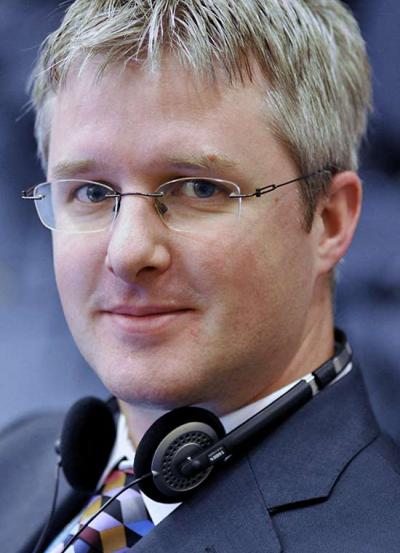

As many of you may know, today .ORG announced that all of its 8.5 million domains are now able to be fully DNSSEC signed - the largest set of domain names in the world so far that has access to this key security upgrade. .. The widespread publicity that the Kaminsky bug got around the world vindicated a decision made in several companies to invest time, effort and money into deploying DNSSEC. The community was split on the value of the DNSSEC effort -- many thought the deployment was quixotic, while a few others thought it was appropriate.
 Attendees at the public ICANN meeting in Brussels today heard from over two dozen companies that have implemented or are planning to support DNSSEC, the next-generation standard protocol for secured domain names. It is clearer than ever before that DNSSEC is becoming a reality.
Attendees at the public ICANN meeting in Brussels today heard from over two dozen companies that have implemented or are planning to support DNSSEC, the next-generation standard protocol for secured domain names. It is clearer than ever before that DNSSEC is becoming a reality.
 This Friday, it looks as though the ICANN Board will follow the clear conclusions drawn by its independent review and approve dot-xxx. Given the importance of the first use of the review process, the importance of the Board being seen to be accountable and the fact that the community was pretty unanimous in recent public comment, it is pretty much the only reasonable course of action. The question then is: how do things move forward?
This Friday, it looks as though the ICANN Board will follow the clear conclusions drawn by its independent review and approve dot-xxx. Given the importance of the first use of the review process, the importance of the Board being seen to be accountable and the fact that the community was pretty unanimous in recent public comment, it is pretty much the only reasonable course of action. The question then is: how do things move forward?
 Global brand protection powerhouse MarkMonitor recently released survey results revealing the intentions of their corporate clients with respects to new gTLDs. After reading the report, it's fair to say that I'm not surprised by the results, but continue to be frustrated by them. Where are all of these forward thinking and revolutionary online marketers and brand managers? Are they so unaware of the opportunity that has been placed before them or are they just being very savvy?
Global brand protection powerhouse MarkMonitor recently released survey results revealing the intentions of their corporate clients with respects to new gTLDs. After reading the report, it's fair to say that I'm not surprised by the results, but continue to be frustrated by them. Where are all of these forward thinking and revolutionary online marketers and brand managers? Are they so unaware of the opportunity that has been placed before them or are they just being very savvy?
 As the shorter of the ICANN interregnums comes to a close and the ICANN faithful finalize their dinner reservation agendas for Brussels, it is time again for a preview of what will be 'on-tap' at next week's ICANN meeting. While, as always, there is a lot going on in ICANN Land, a scan of the blogosphere and ICANN list serves suggests that the four most discussed topics will be...
As the shorter of the ICANN interregnums comes to a close and the ICANN faithful finalize their dinner reservation agendas for Brussels, it is time again for a preview of what will be 'on-tap' at next week's ICANN meeting. While, as always, there is a lot going on in ICANN Land, a scan of the blogosphere and ICANN list serves suggests that the four most discussed topics will be...
 On Monday, June 21, ICANN convenes in Brussels, hosting its "Welcome Ceremony" for attendees. In advance of the session, the agenda for the Board meeting on Friday, June 25 has been released. As is the fashion, it lists significant issues without being too specific or tipping the Board's hand. It also allows for matters that arise organically during the week of the meeting to (possibly) be heard.
On Monday, June 21, ICANN convenes in Brussels, hosting its "Welcome Ceremony" for attendees. In advance of the session, the agenda for the Board meeting on Friday, June 25 has been released. As is the fashion, it lists significant issues without being too specific or tipping the Board's hand. It also allows for matters that arise organically during the week of the meeting to (possibly) be heard.
 In part two of The [Dot] Brand Tribes we argued that introducing new branded generic Top-Level Domains (gTLDs) would bring value to brand owners and have positive effects on customer recognition. In this last post we'll continue that theme and talk about how brand owners can come together to provide shared spaces using the banking industry as an example.
In part two of The [Dot] Brand Tribes we argued that introducing new branded generic Top-Level Domains (gTLDs) would bring value to brand owners and have positive effects on customer recognition. In this last post we'll continue that theme and talk about how brand owners can come together to provide shared spaces using the banking industry as an example.
 With great anticipation I waited for the most recent Applicant Guidebook version 4 aka DAG4. I was looking forward to seeing gTLD program timeline. Was it possible that ICANN would give us another timeline and be firm with it? And then I saw it. Those 3 letters next to the new October 2010 launch date: tbd. So the date is October 2010 but it is "To Be Determined"? On one hand we have a set date but on the other hand it is yet to be determined.
With great anticipation I waited for the most recent Applicant Guidebook version 4 aka DAG4. I was looking forward to seeing gTLD program timeline. Was it possible that ICANN would give us another timeline and be firm with it? And then I saw it. Those 3 letters next to the new October 2010 launch date: tbd. So the date is October 2010 but it is "To Be Determined"? On one hand we have a set date but on the other hand it is yet to be determined.
 Staggering! According to the annual Interbrand Top 100 Brands report for 2009 the top 10 global brands are worth $422,901 ($m). Good leadership, innovation, protection, reach and solid products have created lasting consumer relationships and new entanglements that drive that amazing number. In this post from my original series back in March 2010, we'll discuss the high level value a dot brand could create.
Staggering! According to the annual Interbrand Top 100 Brands report for 2009 the top 10 global brands are worth $422,901 ($m). Good leadership, innovation, protection, reach and solid products have created lasting consumer relationships and new entanglements that drive that amazing number. In this post from my original series back in March 2010, we'll discuss the high level value a dot brand could create.
 On April 16 ICANN issued a breach notice to Turkish Registrar Alantron for not consistently providing access to its WHOIS database via Port 43, a command-line query location that all Registrars are required to supply under conditions of their contract with ICANN under section 3.3.1. Four days later they issued a breach to Internet Group do Brazil for the same problem. ... The WHOIS record, as we all know, is a massive fraud with illicit parties filling records with bogus information and hiding behind anonymity.
On April 16 ICANN issued a breach notice to Turkish Registrar Alantron for not consistently providing access to its WHOIS database via Port 43, a command-line query location that all Registrars are required to supply under conditions of their contract with ICANN under section 3.3.1. Four days later they issued a breach to Internet Group do Brazil for the same problem. ... The WHOIS record, as we all know, is a massive fraud with illicit parties filling records with bogus information and hiding behind anonymity.